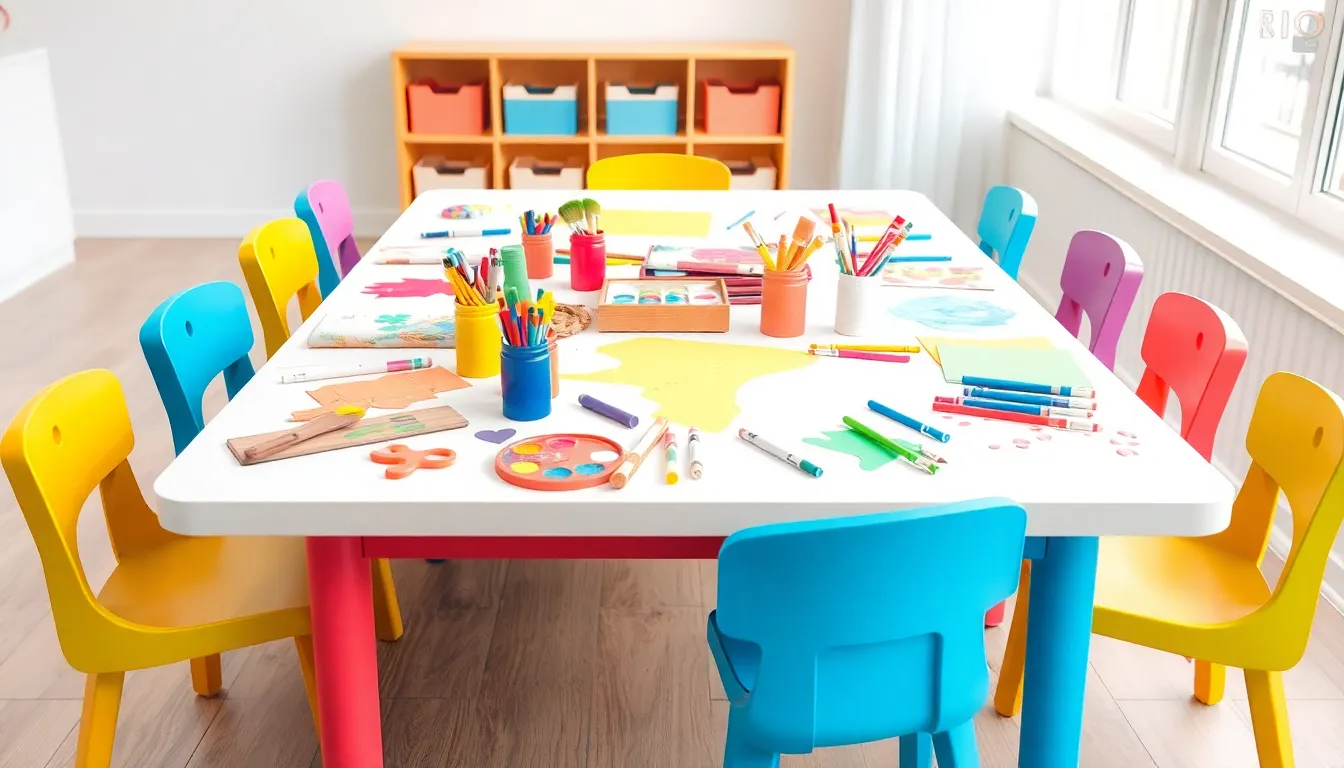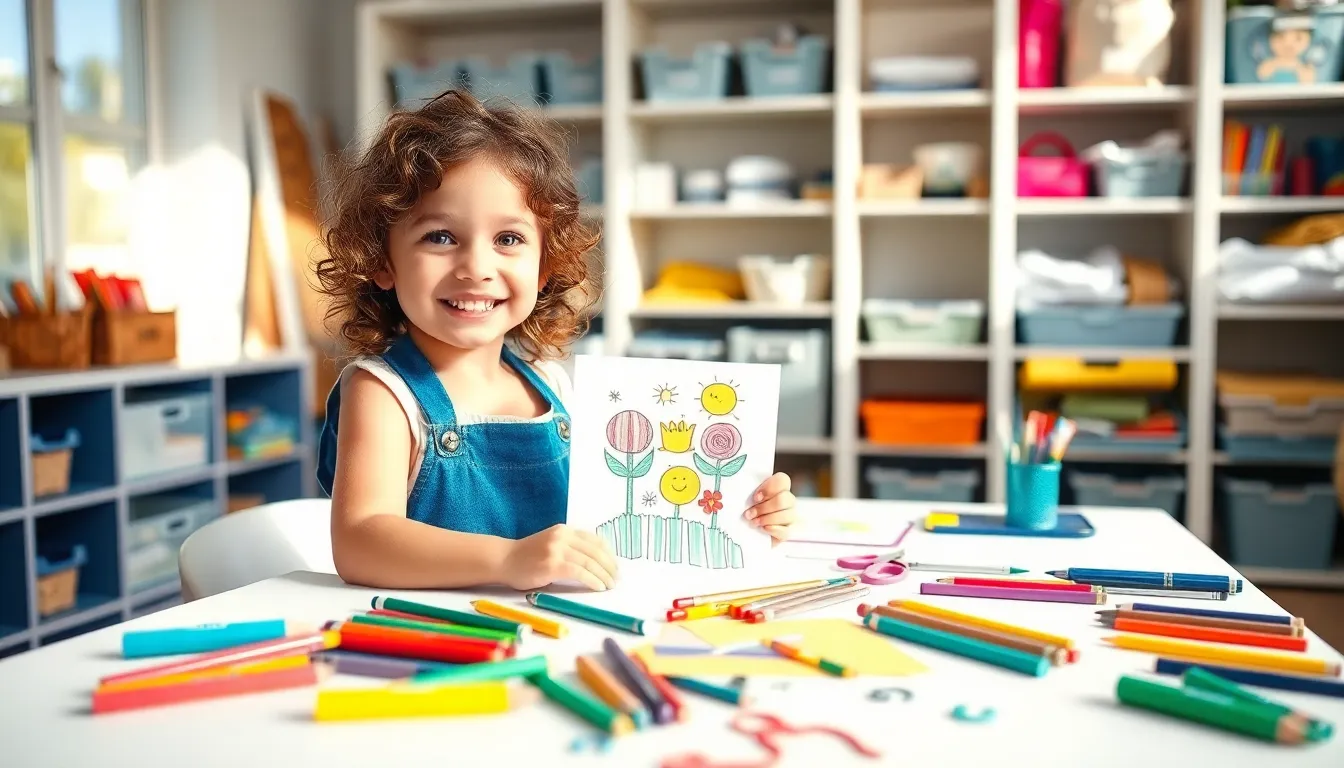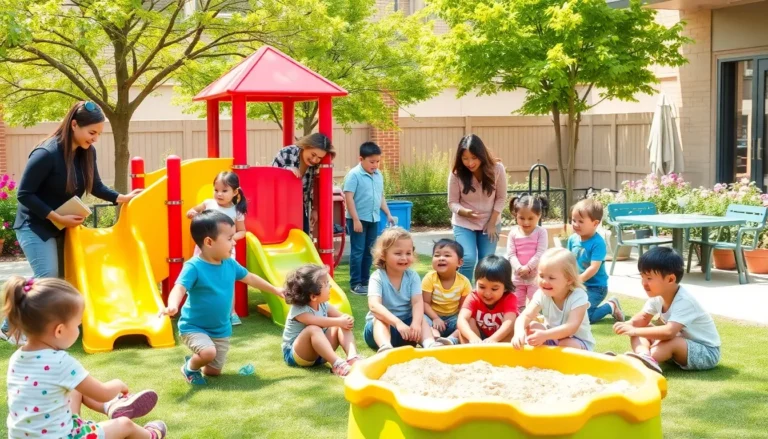Every parent knows that kids and creativity go together like peanut butter and jelly. But where do all those masterpieces happen? Enter the kids’ arts and crafts table, the ultimate playground for little Picassos. This magical space isn’t just about crayons and glitter; it’s where imagination takes flight and messes become memories.
Table of Contents
ToggleImportance of a Kids Arts and Crafts Table
A dedicated arts and crafts table offers an essential space for children to unleash their creativity. This environment encourages exploration and imaginative play, fostering a love for art.
Fostering Creativity
Creativity flourishes in an organized setting. An arts and crafts table gives children the freedom to experiment with various materials. It allows for the combination of paint, paper, and other supplies. Kids express emotions through their artwork, which builds confidence. Original ideas emerge as they explore different techniques and styles. Children discover their unique artistic voices. This process encourages problem-solving skills, as they learn to navigate challenges in their art projects. Ultimately, this table becomes a catalyst for imagination and self-expression.
Developing Fine Motor Skills
Fine motor skills improve significantly with arts and crafts activities. Children engage in tasks that require hand-eye coordination, such as cutting, gluing, and coloring. These actions enhance dexterity in fingers and hands. Various tools like scissors and brushes develop grip strength. Repeated use of these tools helps refine muscle control. As kids manipulate small objects, they gain precision in their movements. This skill set translates to everyday tasks, including writing and typing. A dedicated space for these activities ensures ongoing development in a fun way.
Choosing the Right Table

Selecting a suitable kids arts and crafts table requires careful thought and consideration. The ideal table offers ample space and the right materials for creative activities.
Size and Space Considerations
Size plays a crucial role in table selection. Ensure sufficient space allows for movement and seating while accommodating supplies. Consider the number of children participating; a larger table suits multiple artists better. Space constraints can dictate table dimensions. Height requirements are essential as well; tables should align with children’s comfort for prolonged use. A table that grows with the child can provide lasting value.
Materials and Durability
Materials directly affect the table’s longevity. Choose surfaces that withstand spills and scratches, as arts and crafts activities often involve messy materials. Opt for easy-to-clean surfaces like plastic or laminate. Sturdy construction is vital for stability during use. Consider tables made from solid wood or reinforced materials for extended durability. Non-toxic finishes ensure safety during creative play. Investing in a quality table enhances the overall crafting experience for kids.
Essential Supplies for a Kids Arts and Crafts Table
Creating a vibrant arts and crafts table requires essential supplies that inspire creativity. Parents and caregivers can curate an engaging, imaginative space with the right tools.
Basic Art Supplies
Markers, crayons, and colored pencils should always be readily available for drawing and coloring projects. Paper of various sizes and textures, including construction paper and sketch pads, offers a backdrop for countless creations. Scissors and glue sticks enable children to cut and assemble their masterpieces. Paints, including watercolors and acrylics, allow for exploration of different artistic techniques. Additional items like stamps and stickers encourage playful embellishments on finished artwork. These basics form a solid foundation for any children’s crafting experience.
Organization and Storage Solutions
Effective organization can enhance the crafting experience significantly. Storage bins and caddies provide designated spaces for supplies, making cleanup easier. Clear containers enable children to see available materials, promoting independent exploration. A pegboard can serve as a versatile solution, holding tools and frequently used items within reach. Labeling shelves and bins fosters a sense of responsibility and ownership among kids. By prioritizing organization, creativity thrives in a well-structured environment.
Creative Activities for Kids
Encourage creativity with a variety of engaging activities designed for children’s arts and crafts tables. Young artists thrive when presented with projects suitable for their age, enhancing their skills and imagination.
Age-Appropriate Craft Ideas
Toddlers enjoy simple crafts like finger painting and collage-making. Preschoolers benefit from projects that involve cutting and pasting colorful paper shapes. Children aged six to eight can delve into more complex tasks, such as making friendship bracelets or building with clay. Older kids might explore painting on canvas or learning basic sewing techniques. Each activity fosters creativity and builds essential skills at every developmental stage.
Seasonal and Holiday Projects
Seasonal projects add excitement to the arts and crafts experience. During autumn, kids can create leaf rubbings and pumpkin decorations. Winter projects might include making handmade ornaments and snowflake cutouts. Spring offers opportunities for flower-themed crafts like paper bouquets or watercolor paintings. For summer, children can design their own beach-themed art using shells and sand. Aligning projects with holidays engages kids in festive creativity, making the process even more enjoyable.
Maintaining the Kids Arts and Crafts Table
A well-maintained kids arts and crafts table enhances creativity and fosters a positive environment for artistic expression. Regular upkeep ensures that the space remains inviting and organized.
Cleaning Tips and Tricks
Establishing a cleaning routine keeps the arts and crafts table neat. Wipe down surfaces with a damp cloth after each use to remove stains and debris. Use child-friendly cleaners to ensure safety. Keep nearby storage areas free of clutter by organizing supplies in labeled bins. Encourage children to help with cleanup to instill a sense of ownership. Designate specific days for a thorough clean, which includes sorting through supplies, discarding unusable items, and restocking necessary materials. Ultimately, a clean environment keeps creative juices flowing and makes crafting enjoyable.
Encouraging Responsibility in Kids
Teaching responsibility at the arts and crafts table assists children in developing life skills. Assign specific tasks to each child, such as organizing supplies or setting up the crafting area. Praise them for their efforts to reinforce positive behavior. Discuss the importance of taking care of shared spaces, highlighting how everyone benefits from a tidy environment. Incorporate fun challenges, like keeping their workspace clutter-free while they create. Promote accountability by allowing children to monitor their crafting materials, helping them recognize when supplies are low. Nurturing responsibility fosters independence and prepares them for future collaborations.
Creating a dedicated arts and crafts table is essential for nurturing children’s creativity and self-expression. This space not only encourages imaginative play but also fosters important skills like problem-solving and fine motor development. By selecting the right table and organizing supplies effectively, parents can create an environment that inspires exploration and artistic growth.
Regular maintenance of the crafting area promotes responsibility and ownership among children, making the experience more enjoyable. Engaging in seasonal projects and age-appropriate activities keeps the creative spirit alive, ensuring that every crafting session is both fun and educational. Ultimately, a well-equipped arts and crafts table becomes a cherished space where children can unleash their creativity and build lifelong memories.




